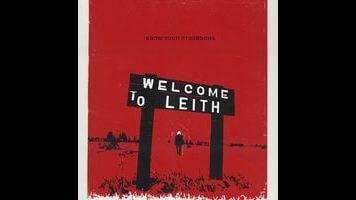Welcome To Leith gets up close and impersonal on a white-supremacist takeover

In documentary filmmaking, confrontation scenes are often the Holy Grail: It’s one thing to get talking heads calmly recalling conflict, but it’s far more compelling to catch conflict live and electric, as it happens. On that count, Michael Beach Nichols and Christopher K. Walker’s documentary Welcome To Leith is documentary gold. After reading a New York Times article about an infamous white-supremacist shit-stirrer who was out to turn the tiny North Dakota town of Leith into a white haven run by simpatico racists, Nichols and Walker made several trips to Leith, and their cameras capture plenty of hate-mongering and aggression on both sides. But their live footage of city council shout-downs and building-burnings don’t tell enough of the story: They capture the emotion, but not enough of the context around it.
Leith is stretching the definition of a town. As Mayor Ryan Schock describes it, it’s “three square miles and 24 residents, with the children,” and the only working business in town is the local bar. “It’s very rural America,” he says. “Everybody has each other’s backs.” That changed when Paul Craig Cobb bought a few vacant buildings and lots, sold some of them for a buck apiece to other white supremacists, and put out a call online for white “prison graduates” and skinheads to come join him in democratically taking over the town by simply out-populating and outvoting the locals. The Southern Poverty Law Center publicized his effort, the Times picked up the story, and the local news took notice—along with a few outsiders, like a National Geographic film crew and Nichols and Walker. The two men, who previously worked together in a variety of behind-the-scenes roles on the dance-doc Flex Is Kings, launched a Kickstarter to complete the film, but otherwise paid for their costs out of pocket, returning to Leith for three-week stays several times during the months-long face-off between Cobb and his cronies, and area residents, who came from beyond Leith to throw protest rallies and contrive legal means to push the racist groups out of town.
Much of Welcome To Leith’s on-site footage is beautifully shot, especially the outdoor sequences; when residents burn one of Cobb’s buildings after getting it condemned, it’s easy to get caught up in the fantastic use of light and darkness, and miss out on questioning the legality and moral rectitude of the situation. Nichols and Walker remain scrupulously neutral, so much so that it’s easy to imagine neo-Nazis watching this film without seeing anything more than a set of sympathetic eyes and ears capturing how hard nice, hard-working white folks have it in a country where they’re outnumbered by vicious mongrel races. Cobb and one of his first Leith invitees—squirrelly, Hitler-mustached National Socialist Movement member Kynan Dutton, at one point captured giving the Nazi salute and shrieking “Sieg heil!” during a city council meeting—each get their share of screen time, holding forth about how persecuted they are, how it’s a shame to see whites betraying each other, and how the best way to stop Jews is by “physically taking apart their molecules and atoms.”
And while Cobb’s rhetorical methods are smug, disingenuous, and as aggressive and hateful as his supremacist beliefs, the Leith locals don’t come across particularly well either. People alternating hysteria and profanity are ugly, no matter what beliefs they’re espousing or defending. At times, it feels like Cobb was always more interested in causing a scene and drawing attention, persecution, and possible sympathy than in establishing a rural foothold for a few rictus-grinning malcontents. And he certainly got all the confrontation he could handle.
But that’s where Welcome To Leith could stand less passive observation, and more pointed journalistic inquiry. Nichols and Walker don’t seem to have asked any of the interesting questions, like how the Leith residents feel about the outside attention, or what went through Cobb’s mind when he staged an armed “patrol” of the town that got him and Dutton jailed. Whatever was on his mind during that rifle-toting march around town, he made sure Dutton’s wife filmed the entire thing, including a moment where he brags about being “one of the most famous racists in the world.” Nichols and Walker got close access to him by staying neutral, but they didn’t use that access to gain insight, or track what was happening between their Leith visits. Their documentary leaves plenty of questions about what happened to the other NSM members who wound up owning Leith land, why Cobb’s plan was such a slow starter, what he thinks about what he accomplished, and more.
The directors capture some striking moments, though those sequences often seem more like they belong in a horror feature than a doc: When the camera pushes in slowly on swastikas painted on trees around Cobb’s home, while ominous, minimalist music and low percussion beats play, it feels like Nichols and Walker are trying to set up the next Blair Witch movie. Their film evokes plenty of feeling, and captures plenty more as it happens. It could just use more overt and significant thought around the feeling. A solid documentary feeling of “you are there” isn’t always a substitute for “…but here’s what happened when you left, and here’s what it all meant.”